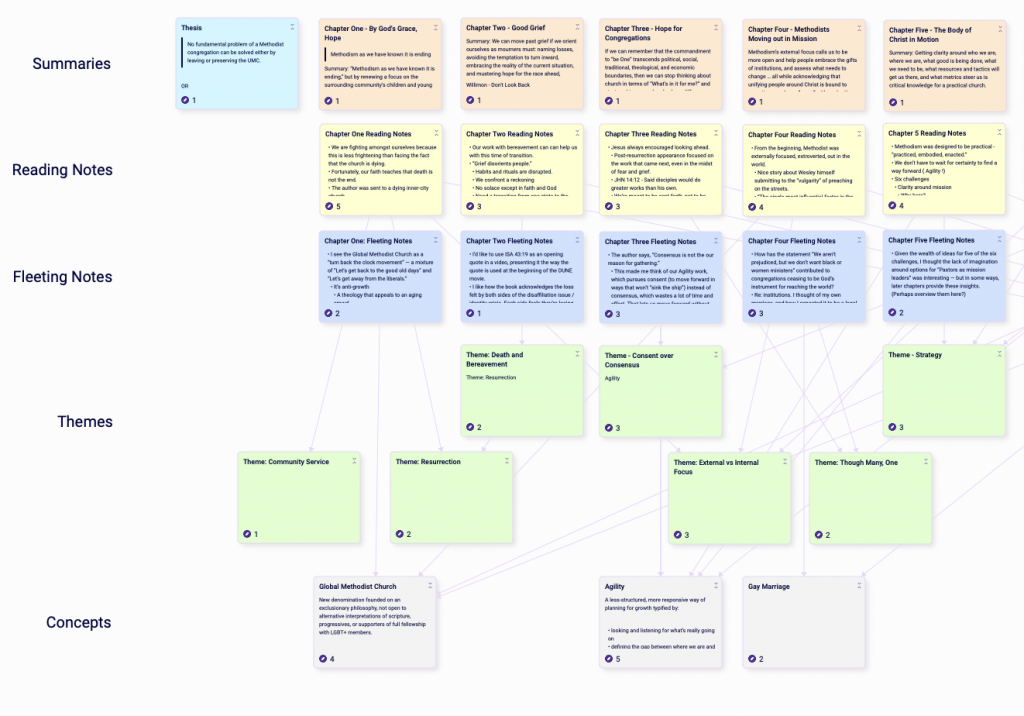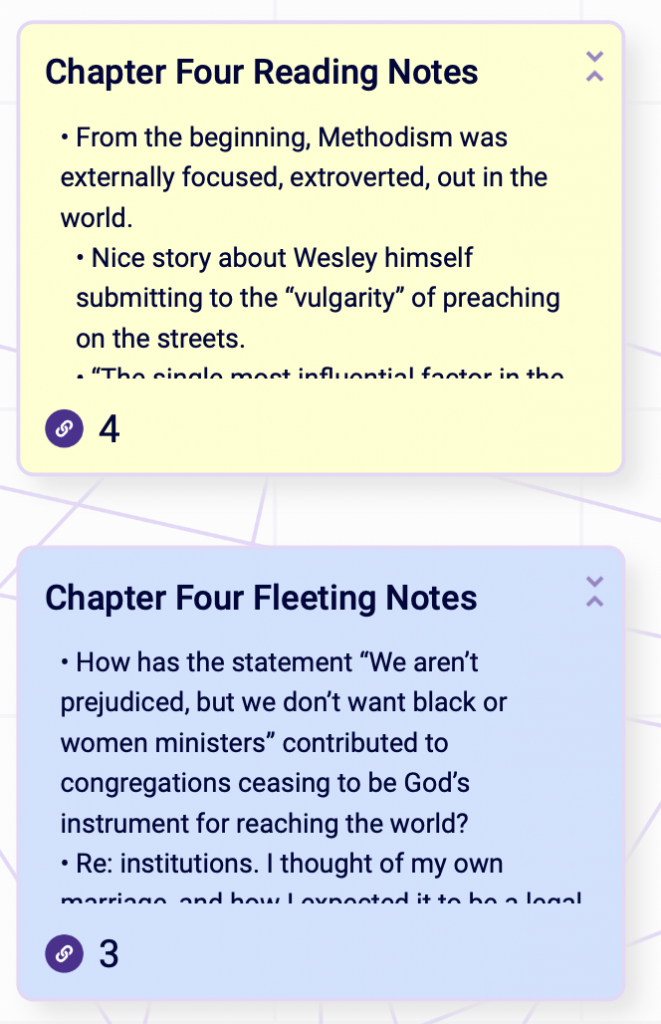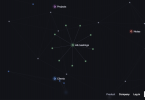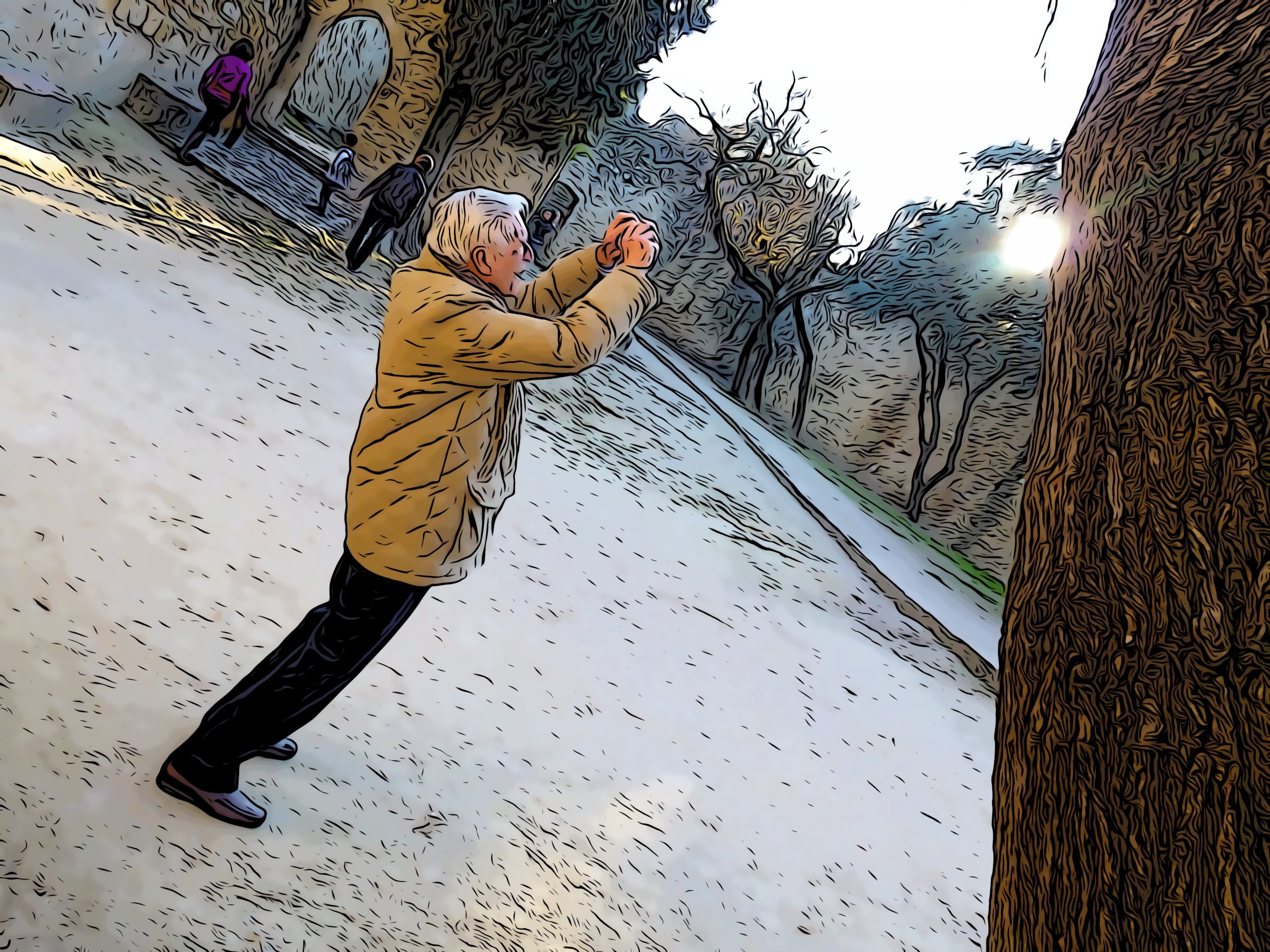Scrintal, yet another tool for thought, has opened for early access, making it possible for those willing to pony up $60.00 per year to “skip the line” and begin exploring right away.
As every tool for thought must these days, Scrintal (say “SREEEN-tuhl”) offers magical backlinks that help users create and discover unexpected connections among notes. But what separates Scrintal from the rest of the pack is its whiteboard-based metaphor, which allows the user to establish spatial relationships (in addition to or in lieu of links) among notes.
The creators joke that Scrintal is like “Mural and Obsidian having a baby” together. That description, while too cute by half, is not far off the mark … especially in its positioning of Scrintal as something very young and very promising, but still very much in need of attention, development, and maturity.
How Scrintal Works
Each Scrintal note is, essentially, a sticky note, and as the user, you decide whether the contents of each note will be atomically short or infinitely long. You create notes on either the desk (an infinite, blank expanse intended for intake and initial organization) or a board (an infinite, blank expanse intended for for gathering, organizing, and storing a specific collection of notes). You have only one desk, but you many have as many boards as you care to create.

Any note you create actually lives in the archive, a vast library of all your notes. You can browse the archive in a timeline view, but most of the time, you’ll retrieve notes from the archive using searches. Once found, ideas can be dragged onto the desk or a board and arranged or grouped in any way you like.
Importantly, a single note can appear on the desk or on any number of boards simultaneously. These multiple instances of a single note work like live embeds; update the content of a note in one place, and it is automagically updated everywhere (with one bizarre exception, which we’ll cover later).
Taking Scrintal for a Test Drive
To immerse myself in Scrintal, I used it to take notes on a non-fiction book I needed to read and summarize in 48 hours. (The book itself, of absolutely no interest to anyone other than contemporary United Methodists, is Don’t Look Back by Will Willimon.) This being my very first foray into Scrintal, I had to learn about cards, the desk, boards, and organization as I went.
In the beginning, I created one card for each chapter of the book. I also divided each card into two sections: the upper half for reading notes (restatements of the author’s ideas in my own words) and the lower half for fleeting notes (ideas of my own that occurred to me as I read). This decision brought me face to face with the first of many pain points: Scrintal currently lacks a templating feature of any kind, so any kind of recurrent formatting has to be done manually … or with a text expander.
This decision left me typing reading notes in the upper half and fleeting notes in the lower half of one long document per chapter. After growing weary of constantly scrolling up and down, I tried one of my Obsidian tricks: opening two windows on the same card (one looking high, at reading notes, and the other looking low, at fleeting notes). But even though the app allows cards to be embedded into several different boards, Scrintal can’t currently open two instances of the same card on one board.
Pain Points Galore
“No worries,” I thought. “I’ll just add a collapsable header to each section, and toggle them open and closed with a single click as needed.” Nope. Scrintal currently lacks collapsable bullets and headers. (You can collapse an entire card down to its title, but not sections within the card.)
In the end, I decided to break each note into two: a yellow one (“Chapter One – Reading Notes”) for reading notes and a blue one (“Chapter One – Fleeting Notes”). This gave me the ability to have two note windows open at once … but opened another Pandora’s Box of challenges.

Before long, I realized my initial naming convention wouldn’t scale well. What would happen when I started reading a second book … and a third … and a fourth … and all of these had chapter notes with identical titles? As it turns out, Scrintal does allow notes to have identical titles … but this raises problems of it own. Future Mark is bound to be frustrated when his search for interesting or unexpected connections produces hundreds of notes all titled “Chapter One – Reading Notes!”
(This scenario turns out to be unlikely, by the way — but for bad reasons. Scrintal currently searches note titles, but not note contents … so attempts to bring up related cards based on a keyword search would fail!)
Arrrgh! Fine. I came up with a naming scheme integrating the title of the book, producing unique titles for each note (“Don’t Look Back – Chapter One – Reading Notes,” etc.). After manually retitling all cards, I discovered a major pain point: when you change the title of a note, Scrintal currently doesn’t update links associated with that card. Every link I’d made to existing cards? Broken.
Organizing Ideas in Scrintal
Frustrated, I turned to the (helpful, friendly) Scrintal Slack community for ideas. One idea seemed especially practical: to summon all cards related to Don’t Look Back together again, tag each with a unique tag (like #dont_look_back). I didn’t look forward to typing that hashtag into every card created so far! Happily, Scrintal will apply a tag to a selection of multiple cards.
There! Lovely! Scrintal search makes tags first class citizens (that is, there’s a portion of the right-hand sidebar dedicated to listing them.) Clicking one of those tags will summon all cards associated with it, and from there it would be easy for Future Mark to drag all cards tagged with #dont_look_back to the desk for a working session.
This was functional, but stuck in my craw a bit, as I typically use tags very sparingly, and only to indicate status (#To_Read, for example, or #Completed). Over time, at one tag per book (or post, or video), I’d end up with a lot of tags … and each time I wanted to share all my notes on a given source, I’d have to summon all those notes, pull them onto the desk, and arrange them into some kind of useful structure.
And then it hit me: Scrintal’s boards could function a lot like folders! Instead of using tags, I could create a board for each source (in this case, a board called “Don’t Look Back”) and arrange all notes from that source on a single board! And because Scrintal allows a read-only view of any board to be shared as a link, I could easily create an attractive layout I could share with interested friends.
Over time, this approach will, of course, eventually create hundreds and hundreds of boards … but in theory Scrintal allows unlimited boards (though I hear from others that a large collection of boards quickly becomes awkward to manage, just as a large collection of folders could).
Book Outlining Insights
Whew! To recap: now I had a unique board for all notes taken from Don’t Look Back, a beautiful arrangement of those notes on that board, and a way to share the finished product with others.
(If you want to see the final result, you can see it here.)
On reflection, though, I decided that the next time I took notes on a book, I’d do things very differently:
- I’d create a “Card Catalog” board with one note, containing bibliography info, for every source (book, article, or video) I found valuable.
- I’d create one board for every valued source, with the related Card Catalog card co-located on it.
- I’d leverage Scrintal’s distinctive spatial organization capabilities to create lovely, sharable layouts of my notes for each source.
- Instead of creating long notes with titles based on where I found them (“Don’t Look Back – Chapter One”), I’d create atomic notes — one short note for each idea or insight — and give that note a title reflecting its key content (“The Global Methodist Church is founded on a broad range of exclusionary practices.”). This would create unique titles … and aid in rediscovery (since Scrintal can’t currently search the contents of my notes).
A Quick Retro of My Experience with Scrintal
What I Liked
- I like being able to color-code notes! I wish I could do this in Obsidian, and see those colors reflected in the related nodes on my graph.
- Scrintal’s ability to establish spatial relationships opens up lots of possibilities. I can arrange cards to reflect the linear structure of the book, or I can arrange them in groups by theme, or I can create a “chart” of throughlines in a novel … the list goes on and on.
- I enjoyed using a project like this one to put Scrintal through its paces. Because I’m using an “Early Access” version of the app, I’m bound to find lots of limits! I have faith that most of these will be addressed by the developers in time.
What I Learned
- I’ve always liked mind-maps and brainstorming on sticky-note boards. Working in Scrintal reminded me of how satisfying it is to see thoughts coalesced into intentionally-arranged notes on a big visual field.
- Scrintal has big potential as a visual/spatial outliner of long-form writing projects (like novels). I can see using card colors to trace throughlines and A-B story interplay … using tags to track characters … and using specialized layouts to visualize where the tentpole moments fall.
- I have a lot of uncertainty around the scalability of Scrintal. How many cards can I create? How many boards? How long before a system that works at one scale begins to feel unmanageable or unwieldy at another?
- Obsidian has no real parallel to Scrintal’s spatial mapping as a way to establish relationships among ideas. That’s a powerful advantage! Most of the time, though, the full potential of this advantage remains untapped, as a lot of manual updating and linking is required to formalize relationships you establish by dragging things around.
- In my mind, cards = notes and boards = folders. But I get the impression that there are other metaphors possible for cards and boards.
- The list of back links is always alphabetized. To take better advantage of this, I’ll start titling notes differently (and more consistently).
- Going forward, I would use the desk (or even specific areas of the desk) to work on projects in progress, and then create boards (and move the associated cards to them) for those projects that feel mature and/or durable.
- I’m thinking a board dedicated to Maps of Content (hello, Nick Milo!) would be useful, as this would become a dependable map of one’s growing idea space with a completely different view of the data than the search feature can generate.
- Not even Scrintal’s creators have really explored the radical potential of what their software should make possible. For now, users have been left pretty much on their own, with little guidance around best practices. I sense a lot of uncertainty — even at the creator level — around what Scrintal wants to be … or has the potential to be.
What I Lacked
- Templates! Templates! Templates!
- Given Scrintal’s essentially visual nature, I felt I should be able to link cards together visually. (Imagine selecting several and, with a click, applying a common link as easily as I can now apply a common tag.) Without this, linking cards requires opening each and manually adding a link.
- A way to combine several cards together into one document for export into a single file. You can select a single card and export it as a Markdown file … but you can’t select multiple cards and output them as a single document.
- A sketching/drawing layer to create boundaries or shaded areas of a board.
- Controls to manipulate line and border thickness.
- Like Mural and many other services, Scrintal supports interactive, collaborative work … but requires a paid membership to engage in collaboration. A lot of us need to collaborate with clients, family members, and friends who will never subscribe to a service like Scrintal. There has to be some way to allow non-subscribers to do more than view a read-only version of a document. (Maybe give me a limited number of “collaborator slots” I can activate by entering someone’s email address, promoting them to collaborator status on demand?)
- Eeek! No find and replace?!?!
What I Longed For
- Less manual maintenance of notes and their content.
- An easy way to merge cards together … or split one card into multiple cards with a single click.
- A way to retitle cards without breaking links. Links to a retitled card should update automatically. Adding this functionality has got to be a top priority; without it, Scrintal becomes essentially worthless as a PKM app.
- My list of “Unlinked Mentions” from Obsidian. The unlinked mentions feature regularly surfaces unexpected relationships among notes. I depend on it heavily.
- Spatial arrange of notes is interesting … but still very much a 2D experience. What would a truly 3D note taking system look like? What if cards could hold other cards, and you could see these relationships in a three dimensional graph? (“My God! It’s full of stars!”)
What’s Next?
Scrintal is still in Early Access, which, I believe, is code these days for “pre-beta.” Developers are adding features aggressively, and a lot of improvements and power are promised for the future. (On a related note: while there is a “Feature Suggestion Board” executed in Scrintal, it seems odd the creators haven’t used Scrintal to create a public-facing product development road map!)
Scrintal will only get better as time goes on. For now, though, Scrintal’s feature set is too limited (and its future too uncertain) to consider it as a functional replacement for Obsidian. Casual users will be frustrated by the lack of basic functionality (reliable search, find and replace, links that update when note titles change), while power users will be frustrated by a lack of extensibility or database functions.
Given Scrintal’s potential, I am delighted to have invested $60.00 in a pre-paid year of service as a way to encourage further development. (By contrast, I do not feel this way about the $500 I invested as a “believer” in Roam Research!) At of October 2022, though:
- people looking for a visual/spatial app for brainstorming and organizing ideas should consider Mural (free for limited personal use, with more features in general, but lacking backlinks).
- serious note-takers and PKM-ers (especially those with large collections of notes) should stick with Obsidian, Logseq, or Roam and wait for Scrintal to mature further.
- investors, early adopters, and those who wish to encourage a rich ecosystem of competing note-taking apps should sign up for Early Access, but be aware of Scrintal’s limitations.







